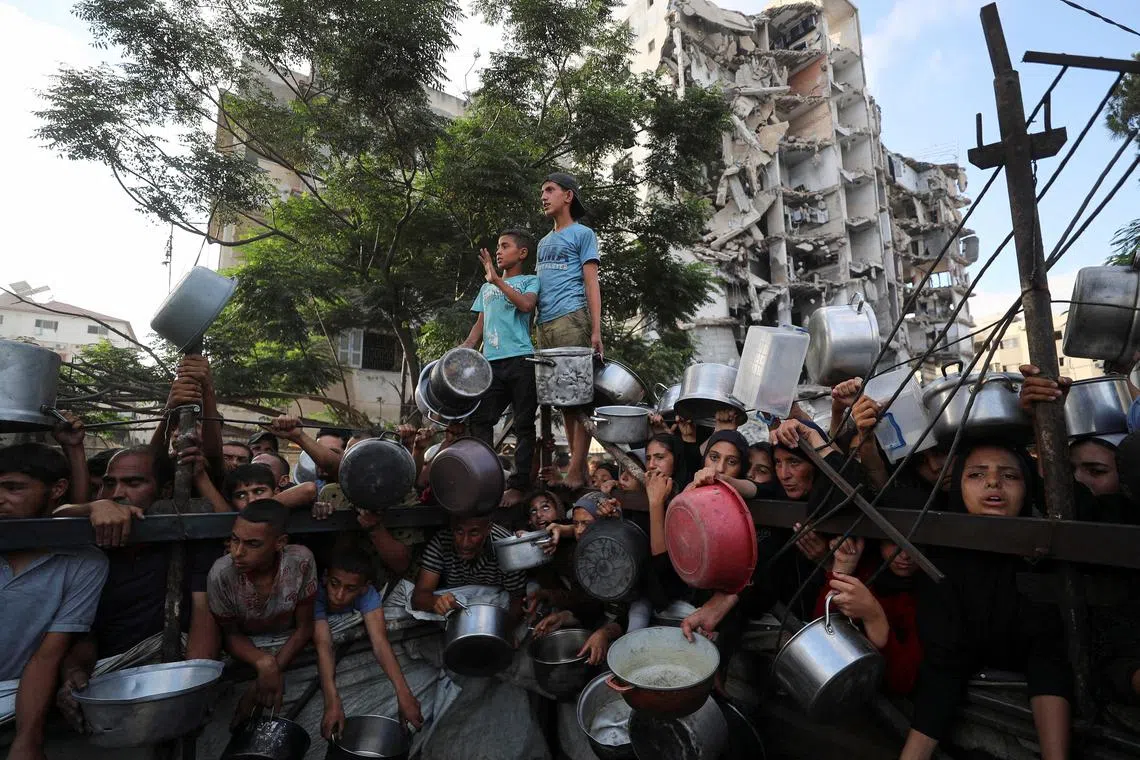Israel’s new ‘humanitarian city’ in Gaza: Leaks and rows, but no real plan
Sign up now: Get ST's newsletters delivered to your inbox

Palestinians waiting to receive food from a charity kitchen amid a hunger crisis in Gaza.
PHOTO: REUTERS
Follow topic:
JERUSALEM – An Israeli scheme to move hundreds of thousands of already uprooted Palestinians to a so-called humanitarian city in Gaza has led politicians to spar with the defence establishment, but officials say a practical plan has yet to be crafted.
Even without a clear blueprint, opposition critics have denounced the proposal, with some likening the suggested site to a “concentration camp”
Israeli Prime Minister Benjamin Netanyahu’s administration has defended the project, saying it would offer civilians a safe haven while further weakening Hamas militants’ grip on Gaza, but it remains unclear whether it is a concrete government policy.
The idea was floated by Israeli Defence Minister Israel Katz earlier in July, and Mr Netanyahu convened ministry and defence officials to discuss it on July 13.
The military was asked to put together a detailed proposition, but Mr Netanyahu dismissed it as far too costly and complicated – two Israeli officials who were present said – and ordered them to come up with something cheaper and faster.
An Israeli military source said it was a complex initiative that required intricate logistics for infrastructure such as sewage, sanitation, medical services, water and food supplies.
Planning was in a very initial phase only, the source said, and the goal was to help Palestinians who do not want to live under Hamas rule.
Some commentators have suggested the real aim of floating the plan was to increase pressure on Hamas during ongoing ceasefire talks, while also appeasing right-wingers in the Cabinet who oppose any truce.
The plan
Mr Katz outlined the plan on July 7 at a briefing with Israeli military correspondents. It followed a proposal by US President Donald Trump, which was publicly embraced by Mr Netanyahu but widely criticised abroad, for Gazans to move to third countries
Almost all of Gaza’s population of more than two million people has already been uprooted during the conflict, which was triggered in October 2023 when Hamas launched a deadly surprise attack on Israel
Mr Katz said last week that around 600,000 people would be moved to the new encampment, to be built in southern Gaza abutting the Egyptian border where Israeli forces have gained control and which, like much of Gaza, now lies in ruins.
The new zone, in Rafah, would be free of any Hamas presence and run by international forces, not Israeli ones, Mr Katz was quoted by both Israel public broadcaster Kan and Army Radio’s military correspondents as saying at the July 7 briefing.
He was also quoted as saying that the people who chose to move there would not be free to leave.
Mr Zeev Elkin, an Israeli minister who sits on Mr Netanyahu’s security Cabinet, told Kan the plan aimed to weaken Hamas’ power in Gaza.
“The more you separate Hamas from the population, the more Hamas will lose. As long as Hamas controls the food, the water and the money, it can go on recruiting militants,” Mr Elkin said.
When asked about concerns the relocations there would be forced and whether the new zone was meant to serve as transit camps with the ultimate aim of expelling Palestinians from Gaza, the military official who spoke with Reuters said: “That is not our policy.”
UN spokesman Stephane Dujarric, when asked about the plan, said: “As we have said multiple times, we firmly stand against any plan that involves forced displacements of civilians in Gaza or forces (them) to make impossible choices.”
‘Mainly spin’
Since Mr Katz’s briefing, Israeli media has been awash with leaks.
Left-leaning Haaretz newspaper on July 9, citing senior military officials, said the plan met resistance from the military because of its legal and logistical challenges.
On July 13, Israel’s N12 News said the military objected to the plan because it could scupper ceasefire talks in Doha, while the Ynet news site cited officials as saying it would cost 10 billion shekels (S$3.8 billion) to 15 billion shekels.
The report drew a rebuke from Finance Minister Bezalel Smotrich, who said some people in the defence establishment were trying to sabotage the plan by presenting inflated budgets.
“Preparing a protected area for the population”, his office said, “is a simple logistical operation that costs only hundreds of millions, an amount that the Ministry of Finance is willing to transfer”.
After the July 13 discussions, hardline National Security Minister Itamar Ben-Gvir dismissed the controversy as a smokescreen to distract from concessions Israel may be willing to make in the ceasefire talks with Hamas.
Mr Ben-Gvir, like Mr Smotrich, wants Israel to press on with the war, Palestinians to leave Gaza and Jewish settlements that were dismantled there two decades ago to be rebuilt.
“The debate surrounding the establishment of the humanitarian city is mainly spin aimed at concealing the deal that is brewing,” Mr Ben-Gvir posted on social media platform X. He said there was no way it could be built during the proposed 60-day ceasefire.
Opposition leader Yair Lapid said on July 14 that the plan was dangerous and would not materialise.
“Will the residents of this city be allowed to leave it? If not, how will they be prevented? Will it be surrounded by a fence? A regular fence? An electrical fence? How many soldiers will guard it? What will the soldiers do when children want to leave the city?” he said at Israel’s Parliament. REUTERS

